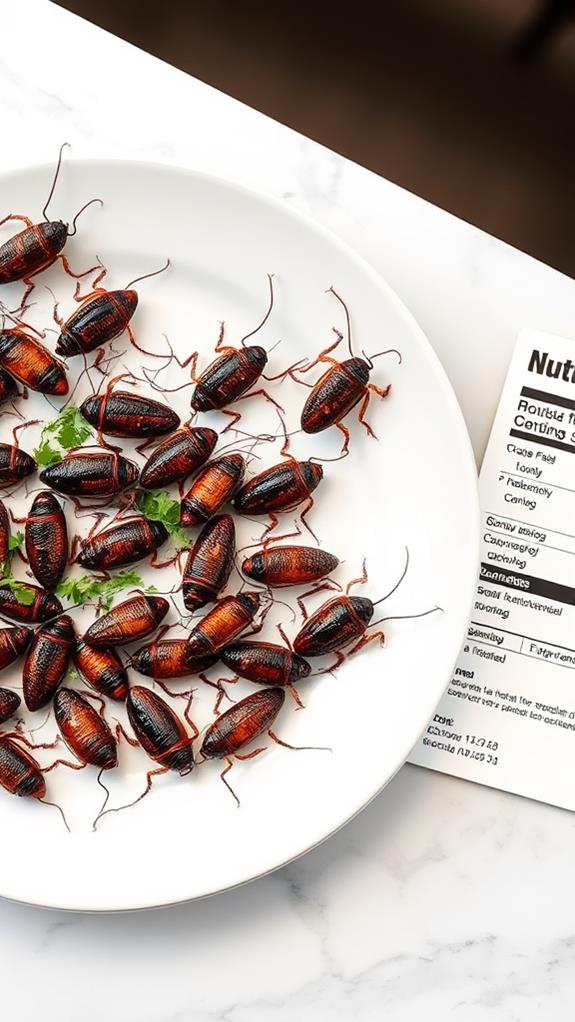Is It Safe to Eat Cockroaches
Eating cockroaches can be safe and nutritious when properly sourced, prepared, and cooked. They're rich in protein, healthy fats, vitamins, and minerals. However, you should be aware of potential risks, including foodborne illnesses and allergic reactions. To minimize these risks, it's essential to obtain cockroaches from reputable suppliers or farm them yourself, and cook them thoroughly at temperatures above 165°F (74°C). Entomophagy, the practice of eating insects, is gaining acceptance in Western countries due to sustainability concerns. While it may seem unusual, cockroach consumption offers environmental benefits and could contribute to future food security. Exploring this topic further will reveal fascinating cultural perspectives and regulatory considerations.
This post may contain affiliate links. If you make a purchase through these links, I may earn a commission at no additional cost to you. Additionally, portions of this post may be generated using artificial intelligence (AI) technology. While we strive for accuracy, please be aware that AI-generated content may not always be perfect and should be fact-checked when necessary.
The Spatula Scoops
- Cockroaches can be safe to eat when properly sourced, prepared, and cooked to eliminate potential pathogens.
- Proper cooking at temperatures above 165°F (74°C) is crucial to destroy harmful bacteria and parasites.
- Allergic reactions are a significant concern, especially for those with shellfish or dust mite allergies.
- Cockroaches offer nutritional benefits, being rich in protein, healthy fats, vitamins, and minerals.
- Sourcing from reputable suppliers or controlled farming environments helps minimize health risks associated with eating cockroaches.
Nutritional Profile of Cockroaches

Cockroaches, often considered pests, actually pack a surprising nutritional punch. You'll find that these insects are rich in protein, containing all nine essential amino acids your body needs. They're also a good source of healthy fats, including omega-3 and omega-6 fatty acids, which are vital for brain function and heart health. Similar to corn, which is utilized in 3,000 applications, cockroaches may have potential uses beyond nutrition, including in biodegradable materials or consumer products.
In terms of micronutrients, cockroaches offer a variety of vitamins and minerals. They're particularly high in vitamin B12, which is essential for nerve function and red blood cell formation. You'll also get a good dose of iron, zinc, and magnesium from these insects. Remarkably, cockroaches contain chitin, a fiber that may have prebiotic properties, potentially benefiting your gut health.
It's worth noting that the nutritional profile can vary depending on the species of cockroach and their diet. For instance, farm-raised cockroaches fed on specific diets may have a more consistent nutritional makeup compared to wild ones. While the idea of eating cockroaches might not appeal to everyone, their nutritional benefits are undeniable, making them a potential sustainable protein source for the future.
Cultural Perspectives on Entomophagy
You'll find that eating insects, including cockroaches, has been a traditional practice in many cultures around the world for centuries. In recent years, there's been a growing interest in entomophagy (the practice of eating insects) in Western countries, partly due to its potential as a sustainable food source. This shift in perspective is not unlike Chile's rich culinary diversity, which includes an impressive variety of potatoes and unique local dishes. As people become more aware of the nutritional benefits of insects, you might see a shift in cultural attitudes towards consuming them, including cockroaches.
Global Entomophagy Traditions
Around the world, entomophagy—the practice of eating insects—has been a part of human culture for millennia. You'll find diverse traditions of insect consumption across continents, with each region developing its own unique culinary practices and preferences. From South America to Southeast Asia, insects have been valued not only for their nutritional content but also for their cultural significance.
In many countries, you'll encounter entomophagy as a normal part of daily life. Here are some global traditions you might find interesting:
- Thailand: Fried crickets and bamboo worms are popular street foods.
- Mexico: Chapulines (grasshoppers) are seasoned and eaten as snacks or in tacos.
- South Africa: Mopane worms are harvested, dried, and often served with tomato sauce.
- Japan: Inago (locusts) are cooked in soy sauce and sugar as a delicacy.
These traditions highlight the versatility of insects as a food source. While Western cultures have been slower to adopt entomophagy, global food security concerns and sustainability efforts are driving increased interest. You'll find that insects are now being incorporated into everything from protein bars to gourmet dishes, reflecting a growing acceptance of this ancient practice in modern cuisine.
Shifting Cultural Attitudes
While entomophagy has deep roots in many cultures, Western attitudes toward eating insects are undergoing a significant shift. You'll notice that what was once considered taboo is now gaining traction as a sustainable food source. This change is driven by several factors, including environmental concerns, nutritional benefits, and food security issues.
In recent years, you've likely seen an increase in media coverage and product launches featuring edible insects. Influencers and thought leaders are championing insect consumption, helping to normalize the practice. Food technology companies are developing innovative ways to incorporate insects into familiar products, making them more palatable to Western consumers.
However, cultural barriers still exist. You might find that overcoming the "yuck factor" remains a substantial challenge for many. Education plays a pivotal role in this cultural shift. By learning about the nutritional value and environmental benefits of entomophagy, you're more inclined to explore insects as a viable food option. As awareness grows and more people try insect-based foods, you can expect to see a gradual acceptance of this practice in Western societies.
Nutritional Value Perceptions
Perceptions of the nutritional value of insects vary widely across cultures. In some societies, you'll find cockroaches and other insects regarded as a delicacy, while in others, the idea of consuming them is met with disgust. This cultural divide significantly influences how people perceive the nutritional benefits of entomophagy, or insect-eating.
When it comes to cockroaches specifically, their nutritional profile might surprise you. They're often rich in:
- Protein
- Essential amino acids
- Healthy fats
- Various vitamins and minerals
Despite these potential benefits, the perception of cockroaches as pests in many Western countries has led to a widespread aversion to examining them as food. This cognitive dissonance between nutritional facts and cultural norms creates a substantial obstacle to acceptance.
You'll find that in countries where entomophagy is common, people are more likely to recognize and appreciate the nutritional value of insects. This awareness is often passed down through generations, reinforcing positive perceptions. Conversely, in cultures where insects aren't traditionally consumed, you'll encounter more skepticism about their nutritional worth, regardless of scientific evidence.
Potential Health Risks

When pondering eating cockroaches, you should be mindful of potential health risks. Foodborne illnesses are a concern, as cockroaches can carry harmful bacteria and parasites that may survive processing. Similar to the risks associated with undercooked poultry, ingesting improperly prepared cockroaches could lead to infections from pathogens like Salmonella or Campylobacter. You'll also want to reflect on the possibility of allergic reactions, especially if you have known allergies to other arthropods like shellfish or dust mites.
Foodborne Illness Concerns
Occasionally, concerns about foodborne illnesses arise when discussing the consumption of cockroaches. While these insects are consumed in some cultures, it is vital to comprehend the potential risks involved. Cockroaches can carry various pathogens that may cause food poisoning or other health issues if not properly prepared.
When considering eating cockroaches, you should be aware of the following foodborne illness concerns:
- Bacterial contamination (e.g., Salmonella, E. coli)
- Parasitic infections (e.g., roundworms, tapeworms)
- Viral pathogens (e.g., norovirus)
- Fungal spores and toxins
Proper handling and cooking techniques are essential to minimize these risks. You will need to make certain that the cockroaches are sourced from clean environments and not exposed to harmful substances. Thorough cooking at high temperatures can kill most pathogens, but it is necessary to recognize that some toxins may remain heat-resistant.
If you are considering incorporating cockroaches into your diet, it is advisable to consult with a healthcare professional or nutritionist. They can provide guidance on safe consumption practices and help you understand the potential risks and benefits associated with this unconventional food source.
Allergic Reaction Potential
Beyond foodborne illness concerns, allergic reactions pose another potential health risk when consuming cockroaches. You might be surprised to learn that cockroaches are a common allergen, especially for people with asthma or other respiratory conditions. The proteins found in cockroach body parts, saliva, and droppings can trigger allergic responses in sensitive individuals.
Here's a breakdown of potential allergic reactions:
| Mild Reactions | Severe Reactions |
|---|---|
| Skin rashes | Anaphylaxis |
| Itchy eyes | Difficulty breathing |
| Runny nose | Swelling of throat |
| Sneezing | Rapid pulse |
If you're considering eating cockroaches, it's pivotal to be aware of your allergy status. Even if you've never had an allergic reaction to insects before, you could still develop one. Those with known allergies to shellfish or dust mites should be particularly cautious, as there's a higher likelihood of cross-reactivity. Before consuming cockroaches, it's advisable to consult with an allergist or healthcare provider, especially if you have a history of food allergies or asthma. They can perform tests to determine your risk and provide guidance on safe consumption.
Preparation and Cooking Methods
Proper preparation and cooking methods are indispensable when considering cockroaches as food. You'll need to guarantee these insects are thoroughly cleaned and cooked to eliminate potential pathogens. First, source your cockroaches from reputable suppliers or farm them yourself to avoid contamination. Then, you'll want to starve them for 24-48 hours to clear their digestive tracts.
Once ready, follow these steps:
- Freeze the cockroaches to humanely kill them
- Rinse them thoroughly in cold water
- Remove wings and legs (optional, but improves texture)
- Cook using high heat methods like roasting, frying, or boiling
It's imperative to cook cockroaches at temperatures above 165°F (74°C) to destroy any harmful bacteria. You can roast them in the oven, deep-fry them for a crispy texture, or boil them before incorporating them into other dishes. Some cultures grind dried cockroaches into a powder, which can be added to flour or used as a protein supplement. Remember, proper cooking not only guarantees safety but also enhances flavor and digestibility. Always handle raw cockroaches with care, using separate utensils and washing your hands thoroughly to prevent cross-contamination.
Sustainability and Environmental Impact

Eating cockroaches could turn out to be a surprisingly sustainable food choice. These resilient insects require minimal resources to thrive, making them an eco-friendly protein source. You'll find that cockroaches consume far less water and feed than traditional livestock, reducing their environmental footprint. They're also efficient converters, turning organic waste into edible biomass.
When you consider the land use implications, cockroaches shine even brighter. They can be farmed vertically in urban settings, minimizing the need for deforestation or agricultural expansion. This aspect of entomophagy, or insect consumption, aligns well with sustainable urban development goals.
From a carbon emissions standpoint, cockroach farming produces considerably fewer greenhouse gases compared to cattle or pig farming. You're looking at a potential reduction in methane and carbon dioxide output, which could help mitigate climate change effects. Additionally, the short life cycle of cockroaches means rapid reproduction rates, ensuring a steady supply without long-term resource commitments.
Regulatory Considerations
The regulatory landscape for edible insects, including cockroaches, is still evolving in many parts of the world. You'll find that different countries have varying approaches to regulating insect consumption. In the European Union, for example, insects are considered "novel foods" and require approval before being sold as human food. The United States Food and Drug Administration (FDA) doesn't have specific regulations for edible insects but requires them to be raised and processed under sanitary conditions.
When considering eating cockroaches, you should be aware of the following regulatory aspects:
- Food safety standards for insect farming and processing
- Labeling requirements for insect-based products
- Import and export regulations for edible insects
- Allergen declarations and potential cross-contamination issues
It's essential to purchase cockroaches or cockroach-based products from reputable sources that comply with local regulations. As the market for edible insects grows, you can expect more thorough guidelines to emerge. Keep in mind that regulations may change, so it's wise to stay informed about the latest developments in your area. Always prioritize your safety and follow official recommendations when exploring entomophagy, the practice of eating insects.
Future of Cockroach Consumption

Looking ahead, cockroach consumption may become more mainstream as global food security concerns grow. You'll likely see increased research into the nutritional benefits and safety aspects of eating cockroaches. Food scientists and entomologists will work on developing palatable recipes and presentation methods to make cockroach-based foods more appealing to Western consumers.
As sustainability becomes a critical factor in food production, you'll notice more companies exploring insect farming, including cockroaches, as a low-impact protein source. This shift may lead to new regulations and standards for insect-based foods, ensuring quality control and safety measures are in place.
You might also witness a gradual change in public perception through targeted marketing campaigns and educational initiatives. These efforts will aim to destigmatize cockroach consumption and highlight its potential benefits. As demand grows, you'll see an expansion of cockroach-based products in health food stores and possibly even mainstream supermarkets.
However, it is crucial to acknowledge that widespread adoption will likely be a slow process, requiring significant cultural shifts and overcoming deep-seated aversions in many societies.
Frequently Asked Questions
Do Cockroaches Taste Like Chicken?
You might be curious about the taste of cockroaches, but they don't actually taste like chicken. While some people claim they have a nutty or woody flavor, opinions vary widely. Cockroaches belong to a different biological order than poultry, so their taste profile is quite distinct. If you're considering trying them, remember that they're often prepared differently in various cultures. Some describe the taste as earthy or even slightly sweet, but it's far from the familiar flavor of chicken.
Can Eating Cockroaches Help Cure Specific Diseases or Ailments?
You've probably heard claims about cockroaches curing diseases, but there's no scientific evidence to support this. While some insects are used in traditional medicine, cockroaches aren't proven to have specific healing properties. They do contain protein and some nutrients, but so do many safer food sources. It's important to rely on scientifically-backed medical treatments for ailments. If you're curious about alternative remedies, always consult a healthcare professional before trying anything new or unconventional.
Are There Any Cockroach Species That Should Never Be Consumed?
You should never consume certain cockroach species due to potential health risks. Avoid eating wild cockroaches, as they may carry harmful pathogens or have ingested pesticides. Species like the American cockroach and German cockroach are particularly dangerous due to their habit of living in unsanitary environments. Stick to commercially raised, edible insects if you're interested in entomophagy. Always research thoroughly and consult experts before consuming any insect species to guarantee your safety and make informed decisions.
How Do Cockroaches Compare Nutritionally to Other Edible Insects?
When you compare cockroaches to other edible insects, you'll find they're quite nutritious. They're rich in protein, essential amino acids, and healthy fats. Cockroaches also contain high levels of iron and B vitamins. However, they're not as protein-dense as crickets or mealworms. You'll get more calcium from black soldier fly larvae, and more omega-3 fatty acids from silkworms. Overall, cockroaches are a decent choice nutritionally, but there might be better options depending on your specific dietary needs.
Can Pet Cockroaches Be Safely Eaten if Properly Prepared?
While it's technically possible to eat pet cockroaches if properly prepared, it's not recommended. You'd need to guarantee they're free from pesticides and parasites, which can be challenging. Even if you raise them yourself, there's still a risk of bacterial contamination. Additionally, pet cockroaches may have different nutritional profiles compared to species typically consumed as food. It's safer and more advisable to stick to commercially raised edible insects if you're interested in entomophagy (insect eating).
Conclusion
As you consider cockroach consumption, weigh the nutritional benefits against potential health risks. You'll need to overcome cultural taboos and guarantee proper preparation methods. While cockroaches offer a sustainable protein source, regulatory hurdles remain. You might find yourself at the forefront of a food revolution, but proceed with caution. Whether you're an adventurous eater or sustainability advocate, the future of entomophagy is evolving. Ultimately, the decision to eat cockroaches rests with you, balancing personal comfort, health concerns, and environmental impact.





